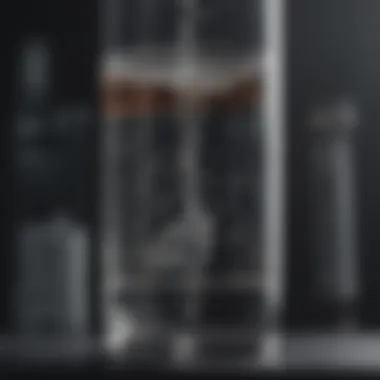Affinity Column Purification: Principles and Applications


Intro
Affinity column purification is a pivotal technique in biochemical research, playing a crucial role in the isolation and analysis of proteins and other biomolecules. This method distinguishes itself by utilizing specific interactions between the target molecule and a ligand affixed to the column matrix. Understanding its principles and applications is essential for students, educators, and professionals in the scientific domain. In this article, we will delve into the key findings from various studies, explore the implications of the research, and highlight advances that shape the future of this technology.
Key Findings
- Summary of the main results: Affinity column purification is proven effective in isolating proteins with high specificity. The ability to selectively bind target proteins allows for greater purity compared to conventional purification methods. Various affinities can be utilized, such as antibody-antigen or enzyme-substrate interactions.
- Significance of findings within the scientific community: The results from affinity purification methods underscore the technique's importance in research. It enhances not only the efficiency of protein isolation but also the analysis of complex biological systems. These findings have broad applications in developing therapeutic proteins, vaccines, and diagnostics.
Affinity chromatography remains one of the most reliable methods for protein purification, facilitating significant advancements in both fundamental and applied biochemistry.
Applications in Real-World Scenarios
Understanding affinity purification extends beyond laboratory techniques. Its implications reach into various fields:
- Pharmaceutical Development: Companies utilize affinity purification to produce monoclonal antibodies, ensuring they achieve the necessary purity for medical use.
- Diagnostics: Techniques like enzyme-linked immunosorbent assay (ELISA) rely on affinity columns for accurate detection of specific biomarkers in clinical settings.
- Research Initiatives: Many research projects focused on protein interactions and functions benefit from such purification methods, providing clearer insights into biological pathways.
Potential Impact on Future Research Directions
The ongoing advancements in affinity column technology hint at promising future research avenues:
- Innovative Materials: Emerging materials for column packing could enhance binding capacities, reduce costs, and streamline the purification process.
- High-Throughput Techniques: Integrating automation in purification protocols might allow large-scale screening, particularly in drug discovery.
In summary, affinity column purification's continual evolution presents new opportunities and challenges, which warrants further exploration and adaptation within the scientific community.
Preamble to Affinity Column Purification
Affinity column purification is a central technique in biochemical research, particularly useful for isolating specific biomolecules. Its significance lies in its ability to selectively purify proteins, antibodies, and other macromolecules based on their unique binding properties. This method capitalizes on the interactions between specific ligands and target molecules, resulting in enhanced purity and yield.
The use of affinity chromatography is not merely a technique but a vital tool in various applications including protein characterization, enzyme studies, and therapeutic development. As researchers seek to understand complex biological processes, the need for efficient purification methods becomes paramount. Affinity purification allows for a targeted approach, minimizing the presence of contaminants that could interfere with subsequent analyses. Therefore, understanding this technique is essential for researchers aiming to achieve reliable results in their experiments.
Key considerations in using affinity column purification include the selection of appropriate ligands, optimization of binding conditions, and strategies for elution. Each of these factors can significantly influence the outcome of a purification procedure. In this article, we will delve into the principles, methodologies, and applications of affinity column purification, providing readers with a comprehensive overview of this important technique.
Definition of Affinity Chromatography
Affinity chromatography is defined as a method of separation that utilizes specific binding interactions between a target molecule and a defined ligand attached to a stationary phase within a chromatography column. The stationary phase is often integrated into the column's matrix, allowing for the selective retention of the target molecule while other molecules pass through. This specificity stems from the inherent affinities that biomolecules have for particular ligands, which can include antibodies, enzymes, hormones, and various other types of molecules.
Affinty chromatography is characterized by several key aspects:
- Specificity: The high specificity of the ligand-target interaction enables the purification of a desired biomolecule.
- Sensitivity: Small amounts of target molecules can be isolated effectively due to the high binding affinities utilized.
- Versatility: Different ligands can be employed for various target molecules, making the technique adaptable for multiple applications.
Historical Development of the Technique
Affinity chromatography has a rich history that can be traced back to the early 20th century. The technique has evolved significantly since its inception. Initial studies focused on the interaction of proteins with specific ligands, laying the groundwork for modern applications.
In the 1970s, significant advancements were made in the development of stationary phases and ligands. One of the landmark developments involved the use of affinity matrices such as agarose and other polysaccharides that provided an ideal environment for ligand attachment. This innovation made it easier to manipulate and scale up purifications, broadening the scope of affinity chromatography's applications in biochemical research.
Through the 1980s and 1990s, the technique underwent rapid expansion, with the introduction of various ligands tailored for specific applications. Researchers became increasingly aware of the potential of affinity chromatography for clinical and industrial uses.
Today, affinity chromatography is considered a cornerstone in protein purification protocols in laboratories worldwide. Its ongoing refinement continues to enhance its efficiency and applicability across various fields in biological research.
Principles of Affinity Column Purification
Understanding the principles of affinity column purification is essential for its effective application in biochemical research. This technique relies on the selective interaction between a target molecule and a specific ligand fixed on the column matrix. These interactions are crucial, as they determine the efficiency and specificity of the purification process. By exploring the fundamental basis of these interactions, as well as the various types of ligands, one can appreciate the versatility and power of affinity chromatography.
Basis of Affinity Interactions
Affinity interactions form the backbone of this purification technique. They are categorized into two main types: specific binding and non-specific interactions.
Specific Binding
Specific binding refers to the selective interaction between a target molecule and its corresponding ligand. This selectivity is the most critical characteristic of affinity chromatography. Specific binding enhances the purification process, resulting in higher yields of the desired product with minimal contaminants. The key advantage of this interaction lies in its high affinity, allowing researchers to isolate proteins or molecules with precision. However, a potential drawback includes the fact that such specific interactions can sometimes lead to elution challenges. The requirement for careful elution conditions is a consideration that researchers must navigate.
Non-Specific Interactions
Non-specific interactions play a different role in affinity chromatography. These interactions often occur between the target and other components in the sample. While they may not contribute to the desired purification, they can still affect the overall process. The key characteristic of non-specific interactions is that they are often weaker and less predictable than specific binding. They can, however, facilitate initial trapping of molecules on the column, which can be beneficial in some contexts. On the downside, such interactions can lead to lower purity levels if not managed properly.
Types of Ligands Used
The choice of ligands in affinity chromatography greatly impacts the performance and outcome of the purification process. Ligands can be broadly categorized into biomolecules and small molecules.
Biomolecules
Biomolecules such as proteins, antibodies, or nucleic acids are frequently used as ligands. Their biological specificity enhances the efficacy of the purification method. The key characteristic of biomolecules is their ability to recognize and bind specific targets with high precision. This makes them popular choices in biological research. While their use can yield favorable results, potential drawbacks include the need for careful handling and the possibility of denaturation, which could affect binding efficiency.


Small Molecules
Small molecules can also serve as ligands in affinity chromatography. They often exhibit a broader range of binding interactions. The defining feature of small molecules is their versatility in binding various targets. This variety allows researchers to tailor purification processes to specific applications. Despite this flexibility, small molecules may not always provide the same level of specificity as biomolecules. Additionally, their smaller size can lead to less stable interactions, which researchers must consider when planning purification strategies.
The success of affinity column purification hinges on carefully selecting both the interaction basis and the types of ligands used.
Components of Affinity Columns
Affinity columns are essential tools in the field of biochemical research, particularly for the purification and analysis of biomolecules. Understanding their components is crucial for optimizing purification processes. Each element of an affinity column plays a pivotal role, contributing to its efficiency and effectiveness. Two main components need thoughtful consideration: the column matrix materials and the ligand attachment methods.
Column Matrix Materials
Column matrix materials provide the physical framework for the affinity chromatography process. They must ensure that the ligands and sample are effectively managed during the purification process.
Agarose Beads
Agarose beads are widely used in affinity chromatography. Their key characteristic is their high porosity, allowing for better interaction with biomolecules. This quality makes agarose beads a beneficial choice for many purification applications. The unique feature of agarose beads is their biocompatibility, which reduces any adverse interaction with biological samples. However, a drawback can include their limited stability at extreme temperatures.
Silica Particles
Silica particles are another component in many affinity columns. The primary importance of silica lies in its mechanical strength. This characteristic ensures that silica particles maintain their integrity throughout the purification cycle. Silica particles tend to have a higher binding capacity when compared to other materials, adding to their popularity. A downside may be their potential non-specific binding, which could lead to contamination in some cases.
Ligand Attachment Methods
Ligand attachment methods determine how effectively the ligand interacts with the target molecule. The right method enhances purification efficiency and specificity.
Covalent Bonding
Covalent bonding is a common method for attaching ligands to column matrices. Its main advantage is the strong and stable interaction it provides. This stability is vital for maintaining the attachment of the ligand during the purification process. Covalent bonding can be a popular choice due to its tailored specifications, allowing researchers to customize how ligands interact. However, the complexity and time required for this method can be a disadvantage.
Non-Covalent Techniques
Non-covalent techniques offer an alternative for ligand attachment. These methods rely on weaker interactions, such as ionic and hydrophobic bonds. The key feature of non-covalent techniques is their ease of application. They are often quicker and less labor-intensive than covalent methods, making them attractive. Nonetheless, a significant downside is their non-permanence; ligands may be lost more easily during purification processes, risking lower yield.
Affinity chromatography relies heavily on the successful integration of its components to achieve optimal purification results.
Operational Mechanics of Affinity Chromatography
Understanding the operational mechanics of affinity chromatography is vital for implementing effective purification processes in biochemical research. This section explores the methods and strategies that render affinity chromatography a preferred technique. The focus will be on sample preparation techniques and elution strategies, which significantly influence the purity and yield of the target biomolecule.
Sample Preparation Techniques
Sample preparation is the initial step in affinity chromatography that can greatly affect the outcome of the purification process. Ensuring that samples are properly prepared can enhance the efficiency of the chromatography process. Common techniques include centrifugation to remove particulates and precipitation to concentrate the biomolecules of interest. These preparative steps directly influence the quality and purity of the starting material, setting the stage for the subsequent affinity separation.
One important consideration is the buffer system used during preparation. The choice of buffer can affect protein solubility and stability, impacting the overall yield. Moreover, maintaining physiological pH is critical to ensure that the binding sites on proteins are available for interactions with the ligands on the column.
Elution Strategies
The elution phase is critical as it determines how effectively the bound target molecules are released from the matrix. Within this section, two primary strategies will be discussed: competitive elution and changing the pH and ionic strength.
Competitive Elution
Competitive elution involves the introduction of a solution containing a competing ligand that binds to the target molecule, displacing it from the affinity column. This method is particularly effective as it allows for efficient recovery of the target compound while minimizing non-specific interactions. The key characteristic of competitive elution is its ability to selectively release the desired biomolecule, maintaining its functional integrity.
Benefits of competitive elution include:
- High Efficiency: This method can often result in a higher yield compared to other elution strategies.
- Target-Specific: It allows for a specific recovery of the target biomolecule.
However, it is important to recognize potential downsides, such as:
- Complexity in Optimization: The choice of the competing ligand must be carefully optimized to avoid undesired reactions.
- Reagent Costs: High-quality competitive ligands may be expensive, which could increase overall purification costs.
Changes in pH and Ionic Strength
Another elution strategy involves altering the pH or ionic strength of the elution buffer. This change can disrupt the interactions between the target biomolecule and the ligand on the column, leading to elution. The advantage of this method lies in its simplicity.
Key characteristics of pH and ionic strength changes include:
- Simplicity: It generally requires fewer additional reagents compared to competitive elution.
- Effective Control: Gradually changing pH can provide better control over the elution profile of the target biomolecule.
While this strategy can be effective, there are caveats that should be acknowledged:
- Solubility Issues: Altering pH indiscriminately can lead to precipitation of biomolecules.
- Stability of the Target: Some proteins might not be stable at extremes of pH, risking loss of activity or structural integrity.


In summary, understanding the operational mechanics of affinity chromatography, especially sample preparation and elution strategies, is critical in ensuring successful purification processes. The techniques addressed here form the backbone of practical application and optimization in affinity chromatography.
Applications in Biochemical Research
Affinity column purification plays a pivotal role in biochemical research, offering a platform for the efficient segregation of biomolecules. This method has gained prominence due to its ability to isolate proteins, enzymes, and antibodies with remarkable specificity. The precision of affinity purification has considerable implications for advancing research in biotechnology, molecular biology, and pharmaceuticals.
Key benefits of applying affinity column techniques in biochemical research include:
- Enhanced Specificity: The interaction between the immobilized ligand and the target molecule enables precise and selective purification. This specificity minimizes the presence of contaminants, which is crucial for downstream applications.
- Time Efficiency: Compared to traditional methods, affinity purification often allows for faster processing times. This is particularly advantageous in high-throughput settings, such as drug development, where speed can significantly affect project timelines.
- Scalability: As the need for protein production scales up, affinity purification can be adapted for larger volumes while maintaining efficiency and specificity. This scalability makes it suitable for industrial applications including the production of therapeutic proteins.
- Improved Yield: The refined nature of this method often results in higher yields of the desired biomolecule, streamlining both research and applications in the pharmaceutical industry.
Protein Purification
Protein purification is perhaps the most well-known application of affinity column purification. This technique is extensively utilized in laboratories focused on characterizing proteins and understanding their function. The specificity of ligand-receptor interactions ensures that pure protein samples are obtained, facilitating in-depth studies of their structure and function.
One common method involves using Protein A or G ligands to capture antibodies from serum or cell culture supernatants. The successful isolation of these proteins can provide insight into immune responses or the development of biopharmaceuticals.
Enzyme Isolation
Affinity chromatography also plays a significant role in enzyme isolation. Enzymes can be purified based on their unique binding affinities. By utilizing specific substrates or inhibitors as ligands, researchers can selectively isolate enzymes, preserving their functional activity. This method not only simplifies the purification process but also enriches the sample for kinetic studies or industrial applications.
The use of affinity columns for enzyme isolation supports various biotechnological advancements, including the development of biosensors and biocatalysis. As a result, industries are able to leverage enzymes in more efficient processes.
Antibody Purification
The purification of antibodies through affinity chromatography is crucial for various applications, including diagnostics, therapeutics, and research. By employing specific antigens as ligands, researchers can effectively isolate antibodies from complex mixtures. This level of purification is essential when producing monoclonal antibodies for targeted therapies in diseases such as cancer.
Furthermore, antibody purification facilitates the development of immunoassays and other diagnostic tools, contributing to advancements in clinical research. The consistent quality of purified antibodies enhances their reliability in experiments and therapeutic applications.
"Affinity chromatography not only enhances the specificity of protein purification but also streamlines the process for practical applications in both research and industry."
The applications in biochemical research illustrate how affinity column purification serves as a fundamental technique. Its relevance cannot be overstated, as it drives innovation and improves the quality of research outcomes.
Advantages and Limitations
In the field of biochemical research, affinity column purification stands out for its effectiveness and efficiency. Understanding its advantages and limitations is essential for researchers and practitioners. The advantages highlight its strengths, while the limitations remind users of potential hurdles. This section delves into these elements, shedding light on crucial considerations when employing this technique.
Benefits of Affinity Purification
Higher Specificity
Higher specificity is a defining trait of affinity column purification. This specificity arises from the selective binding of target molecules to specific ligands attached to the column matrix. It ensures that the desired compounds are isolated with minimal interference from other substances. Such precision is fundamental in applications like proteomics, where the purity of isolated proteins can significantly affect subsequent analysis and experimentation.
A key characteristic of higher specificity is its ability to enhance the yield of the target molecule by reducing the likelihood of co-elution with non-target species. This selectivity is what makes affinity purification an attractive choice for many researchers, especially when dealing with complex biological samples. The unique feature of this method lies in its mechanistic approach to binding, which leverages biological interactions, such as antigen-antibody or enzyme-substrate pairs. The advantage of this high specificity is clear: better quality purified products that are crucial for downstream applications. However, achieving this, requires careful optimization of conditions, as overly stringent conditions might eliminate target molecules alongside contaminants.
Reduced Contaminants
Reduced contaminants are another pivotal advantage of affinity purification techniques. This advantage stems from the highly selective nature of the interactions between ligands and their targets. When employing affinity chromatography, researchers often observe a significant decrease in impurities. This is especially evident when extracting proteins or other biomolecules from complex samples. The result is a cleaner product leading to more accurate results in assays, structural studies, or functional analyses.
A unique feature of reduced contaminants is its contribution to the overall quality of the research output. By minimizing unwanted molecules, researchers can focus on the behavior of the target species without the noise created by contaminants. This is particularly beneficial in protein studies, where even minor impurities can lead to erroneous results. The limitation, however, is that not every affinity column may achieve the same level of purity, leading to variations in reproducibility depending on the chosen method and reagent quality.
Challenges and Drawbacks
Despite the compelling advantages, affinity column purification does have its challenges and drawbacks.
Cost of Reagents
Cost of reagents is a practical issue that may arise when using affinity purification. The high-quality ligands and matrices essential for effective purification can be expensive. This expense is particularly burdensome for academic labs or smaller research groups with limited budgets. While the results may justify the investment in many scenarios, researchers are often forced to weigh the benefits against their financial constraints.
The key characteristic here is the trade-off between cost and quality. Good quality reagents lead to better results but their higher price can limit accessibility. The unique feature of this situation is the pressure it creates on researchers to seek alternatives, such as lower-priced but potentially less effective reagents, or even to modify their experimental designs to reduce reliance on expensive materials. This decision-making process can lead to compromises in the quality or consistency of the results.
Potential Loss of Activity
Potential loss of activity is a concern that cannot be overlooked in affinity purification. During the purification process, there is a risk that target biomolecules may undergo denaturation or lose their functional properties. This issue is especially critical during elution steps, where harsh conditions such as extremes in pH or ionic strength may alter the structure of sensitive proteins.
The key characteristic of this drawback is its implications on the usability of the purified product. If a protein loses its activity during purification, the entire effort may be rendered useless for its intended application. The unique feature here is that researchers must carefully optimize conditions to mitigate these risks, often leading to trial and error in process refinement. This factor can complicate the overall purification strategy and may detract from the efficiency established through the advantages.
In summary, while affinity column purification presents significant advantages such as higher specificity and reduced contaminants, it is vital to consider challenges like the cost of reagents and potential loss of activity. Understanding these elements aids in making informed choices about the technique's application in biochemical research.
Recent Advances in Affinity Column Technology
Recent advances in affinity column technology signify a transformative phase in biochemical research. The evolution in this field highlights enhanced efficiencies and broader applications in protein purification processes. As the demand for high-purity biomolecules increases across various industries, innovative approaches are essential. These developments are not merely a trend; they play an integral role in improving reliability and specificity in the purification process.
Innovative Ligand Design


The design of ligands has undergone significant innovation in recent years. Traditionally, ligands were limited in their functionality and specificity. Now, researchers create custom ligands that exhibit superior binding properties. The ability to tailor ligands means that researchers can target specific proteins with high affinity, which minimizes the chances of non-specific binding.
- Increased Specificity: Custom ligands enable bespoke interactions with target molecules, reducing background noise and contaminants.
- Wider Range of Targets: Innovative designs permit purification of proteins that were previously challenging to isolate.
- Enhanced Stability: New materials and binding strategies increase the longevity of ligands, decreasing the need for frequent replacements.
Overall, the refinement in ligand design is pivotal. It not only enables sharper focus on desired targets but also aligns with the evolving goals of precision medicine and biopharmaceutical development.
Automated Purification Systems
The movement towards automation in affinity column purification systems has led to significant advancements in laboratory efficiency. Automated systems reduce human error and increase throughput. They allow researchers to conduct high-throughput screenings and large-scale purifications with greater consistency.
- Streamlined Processes: Automation simplifies workflows, allowing scientists to focus on data analysis rather than manual interventions.
- Cost Efficiency: By minimizing the labor needed for purification, researchers can allocate budgets more effectively.
- Scalability: Automated systems are easily tailored to scale up for industrial applications without substantial redesign or method changes.
As laboratories continue to emphasize reproducibility and efficiency, the integration of automated systems into affinity purification will likely become standard. Their potential to enhance workflow efficiency cannot be overstated.
Recent innovations in both ligand design and automation reflect a broader trend towards more efficient, precise, and versatile methods in bioseparation technologies.
Comparison with Other Purification Methods
Understanding affinity column purification requires looking at its position among other methods of purification. This section compares affinity chromatography to techniques such as ion exchange, gel filtration, precipitation, and filtration. Each method has unique strengths and weaknesses. Evaluating these aspects provides insight into when and why one might choose affinity purification over others.
Chromatography Techniques
Ion Exchange
Ion exchange chromatography is a method based on the charge of molecules. Proteins or other biomolecules are separated based on their net charge. The sample is passed through a column containing charged resin. One key characteristic of ion exchange is its high resolution. This allows for the fine separation of closely related proteins. Such precision is particularly beneficial when dealing with complex mixtures. The unique feature of ion exchange lies in its ability to manipulate buffer conditions. By altering pH and ionic strength, one can selectively elute desired proteins. However, a disadvantage is the potential for denaturation of sensitive biomolecules during strong elution protocols.
Gel Filtration
Gel filtration is also known as size exclusion chromatography. This method separates molecules based on size rather than charge. Larger molecules elute from the column first, followed by smaller ones. This technique's key characteristic is its straightforwardness, making it user-friendly for those new to chromatography. The unique feature of gel filtration is its ability to maintain the biological activity of proteins throughout the process. However, this method may not be as effective for separating proteins with similar sizes, which can limit its scope in certain applications.
Precipitation and Filtration
Precipitation is another popular method for protein purification. It involves the addition of a precipitating agent to induce the formation of a solid phase. One main advantage of precipitation is its simplicity and low cost. However, it often lacks the specificity that affinity purification provides. This can lead to co-purification of unwanted proteins.
Filtration, on the other hand, uses a physical barrier to separate particles from a solution. Ultrafiltration is widely used in laboratory settings. It can concentrate and purify samples, particularly when dealing with large volumes. The downside of filtration is that it may not be feasible for large-scale applications, which could be a limiting factor in industrial use.
The choice of purification method directly impacts the quality and yield of the purified product. Understanding the differences between these techniques is essential for effective research and applications.
Future Directions in Affinity Purification
Affinity purification is continuously evolving, reflecting both the advances in technology and the growing demands of bioscience research. The future directions of this field are vital for making purification processes more efficient, reliable, and applicable across various sectors. Here, we will explore specific elements, benefits, and considerations that shape the future of affinity purification.
Emerging Trends in Ligand Development
Ligand development is a focal point in optimizing affinity purification. The emergence of new methodologies enables scientists to design ligands that exhibit enhanced specificity and binding affinity for their target biomolecules. Recent advancements in molecular biology techniques, such as CRISPR and synthetic biology, allow for the tailored modification of ligands to increase performance.
For example, designed ligands can incorporate elements that address common limitations in traditional affinity methods, such as non-specific binding or elution inefficiencies. These developments are essential in the context of precision medicine, where targeted therapies may require highly selective purification tools.
Key trends in ligand development include:
- Nanoparticle-based ligands: These have a larger surface area and can be functionalized to target multiple biomolecules simultaneously, increasing throughput of purification processes.
- Smart ligands: Responsive to environmental stimuli, such as pH or temperature, smart ligands allow for targeted and controlled release of bound molecules, significantly enhancing elution strategies.
- Biospecific ligands: Enhancements that mimic natural interactions can vastly improve the selectivity of purification, thereby yielding higher purity samples.
Potential for Industrial Applications
The industrial applications of affinity purification techniques hold significant promise for biotechnology, pharmaceuticals, and related fields. As researchers continue to develop more sophisticated and cost-effective methods, the transition from laboratory to large-scale utilization becomes plausible.
Several factors drive the potential for industrial applications:
- Automation: With the rise of automated systems in laboratories, the efficiency of affinity purification is increased significantly. Automated processes can ensure consistent results and reduce human error, which is critical for industrial settings.
- Cost efficiency: Continuous improvements in the availability of reagents and ligands contribute to reduced operational costs. As the technique becomes more economical, more industries are likely to adopt affinity purification.
- Regulatory compliance: A clearer understanding of quality control measures and adherence to regulations ensures that the outcomes of affinity purification can meet industry standards. This is particularly relevant in pharmaceuticals, where drug purity directly impacts patient safety.
Overall, the future of affinity purification looks promising. With advancements in ligand development and the potential for improved industrial applications, this field will likely play an instrumental role in enhancing research and production processes in the biosciences.
Culmination
The conclusion serves as a critical component of this article on affinity column purification. It synthesizes the information covered throughout the various sections and emphasizes the significance of this purification method in biochemical research. Understanding the intricacies of affinity column purification allows researchers to tailor their approaches to specific applications, enhancing both efficiency and efficacy in protein analysis.
Summary of Key Points
Affinity column purification stands out due to its high specificity in isolating biomolecules. Key points to remember include:
- Mechanism of Action: The technique relies on specific interactions between the target molecule and ligands attached to the column.
- Applications: Common uses involve protein purification, enzyme isolation, and antibody purification. Each application showcases the method's versatility.
- Advantages and Challenges: Benefits such as higher purity levels are offset by challenges like reagent costs and potential loss of biomolecular activity during purification.
Implications for Future Research
Future research in affinity column purification may explore several avenues:
- Ligand Development: Innovative ligands can significantly enhance target binding and specificity, leading to more efficient purification processes.
- Industrial Applications: The scalability of affinity chromatography suggests a promising future in industrial settings, particularly in pharmaceuticals and biotechnology.
- Technological Advancements: Continuous improvements in automation and column design will likely lead to faster, more cost-effective methods.
As researchers deepen their understanding of affinity interactions and develop new technologies, the potential applications of affinity column purification will only expand, providing greater opportunities for breakthroughs in biochemical research.
The future of affinity column purification is not just about enhancing existing methods, but also about exploring uncharted territories in biochemical analysis.







